Impact of Post-Injection Strategies on Combustion and Emissions in a CTL–Ammonia Dual-Fuel Engine
Abstract
1. Introduction
2. Materials and Methods
2.1. Experimental Bench and Instruments
2.2. Test Fuels
2.3. Experimental Procedure and Test Conditions
3. Results
3.1. Combustion and Emission Characteristics Under Different Post-Injection Quantities
3.1.1. Combustion Characteristics Under Different Post-Injection Quantities
3.1.2. Emissions Characteristics Under Different Post-Injection Quantities
3.2. Combustion and Emission Characteristics Under Different Post-Injection Timings
3.2.1. Combustion Characteristics Under Different Post-Injection Timings
3.2.2. Emissions Characteristics Under Different Post-Injection Timings
4. Conclusions
- (1)
- With increased post-injection quantities, heat release in the late combustion stage was enhanced, leading to a delayed CA50 and prolonged CD, particularly under medium-to-high AEF conditions. The post-injection strategy effectively promoted NH3 oxidation and facilitated the release of its latent energy.
- (2)
- At moderate post-injection quantities (8–12 mg), an increase in BTE was observed across all AEF conditions, indicating that appropriate post-injection enhances combustion efficiency. However, excessive injection led to reduced BTE due to deteriorated atomization and increased wall wetting, which impaired fuel-air mixing and heat release.
- (3)
- At low AEF conditions, CO emissions initially decreased and then increased with higher post-injection quantities, indicating that moderate post-injection improves combustion completeness, while excessive injection leads to incomplete combustion and elevated CO levels. NOX emissions consistently declined with increasing post-injection, with greater suppression observed at higher AEFs. THC emissions, governed by the low reactivity of ammonia, rose significantly under medium to high AEF conditions, and post-injection had a limited mitigation effect. Soot emissions were highly sensitive to injection quantity, but ammonia blending effectively diluted carbon sources and suppressed nucleation, resulting in notable soot reduction under high AEF conditions.
- (4)
- Unburned NH3 emissions decreased with increasing post-injection quantity, indicating that post-injection extended the ammonia combustion window and improved its utilization. The most significant reduction occurred at AEF = 5%, where 20 mg of post-injection reduced NH3 slip emissions by 26.3% compared to the no post-injection condition.
- (5)
- Regarding particulate emissions, increasing the post-injection fuel quantity intensifies particle number emissions by promoting the formation of accumulation mode particles. Delayed injection timing leads to an increase in nucleation mode particles, resulting in a higher proportion of ultrafine particles and elevated health risks. Moderate ammonia blending (AEF = 10–15%) helps dilute soot precursors and reduce local peak temperatures, thereby reducing particle formation.
Author Contributions
Funding
Data Availability Statement
Conflicts of Interest
Abbreviations
| AEF | Ammonia energy fraction |
| AEFs | Ammonia energy fractions |
| ATDC | After top dead center |
| BTDC | Before top dead center |
| BTE | Brake thermal efficiency |
| CA | Crank angle |
| CA50 | Crank angle at 50% heat release |
| CD | Combustion duration |
| CTL | Coal-to-liquid |
| DCL | Direct coal liquefaction |
| EGR | Exhaust gas recirculation |
| HRR | Heat release rate |
| ICL | Indirect coal liquefaction |
| ID | Ignition delay |
| NOX | Nitrogen oxides |
| PAHs | Polycyclic aromatic hydrocarbons |
| TDC | Top dead center |
| THC | Total hydrocarbons |
References
- Reitz, R.D. Directions in internal combustion engine research. Combust. Flame 2013, 160, 1–8. [Google Scholar] [CrossRef]
- Fayyazbakhsh, A.; Bell, M.L.; Zhu, X.; Mei, X.; Koutný, M.; Hajinajaf, N.; Zhang, Y. Engine emissions with air pollutants and greenhouse gases and their control technologies. J. Clean. Prod. 2022, 376, 134260. [Google Scholar] [CrossRef]
- Odgaard, O.; Delman, J. China’s energy security and its challenges towards 2035. Energy Policy 2014, 71, 107–117. [Google Scholar] [CrossRef]
- Othman, M.F.; Adam, A.; Najafi, G.; Mamat, R. Green fuel as alternative fuel for diesel engine: A review. Renew. Sustain. Energy Rev. 2017, 80, 694–709. [Google Scholar] [CrossRef]
- Qin, S.; Zhang, X.; Wang, M.; Cui, H.; Li, Z.; Yi, W. Comparison of BGL and Lurgi gasification for coal-to-liquid fuels (CTL): Process modeling, simulation and thermodynamic analysis. Energy 2021, 229, 120697. [Google Scholar] [CrossRef]
- Gill, S.S.; Tsolakis, A.; Dearn, K.D.; Rodríguez-Fernández, J. Combustion characteristics and emissions of Fischer–Tropsch diesel fuels in IC engines. Prog. Energy Combust. Sci. 2011, 37, 503–523. [Google Scholar] [CrossRef]
- Höök, M.; Aleklett, K. A review on coal-to-liquid fuels and its coal consumption. Int. J. Energy Res. 2010, 34, 848–864. [Google Scholar] [CrossRef]
- Williams, R.H.; Larson, E.D. A comparison of direct and indirect liquefaction technologies for making fluid fuels from coal. Energy Sustain. Dev. 2003, 7, 103–129. [Google Scholar] [CrossRef]
- Lyu, Z.; Tang, X.; Zhang, H.; Qiao, X.; Jin, Z.; Shi, L. Experimental characterization on injection and spray of coal-derived liquid fuel. Energy 2024, 310, 133238. [Google Scholar] [CrossRef]
- Jin, C.; Mao, B.; Dong, F.; Liu, X.; Yang, Y.; Chen, P.; Zheng, Z. Effects of indirect and direct coal-to-liquid fuel on combustion, performance, and emissions in a six-cylinder heavy-duty diesel engine. J. Energy Eng. 2018, 144, 4018024. [Google Scholar] [CrossRef]
- Zhang, G.; Qiao, X.; Miao, X.; Hong, J.; Zheng, J. Effect of coal-to-liquid fuel on combustion and emission in a heavy-duty diesel engine. Proc. Inst. Mech. Eng. Part D J. Automob. Eng. 2013, 227, 481–489. [Google Scholar] [CrossRef]
- Zhu, J.; Wang, Z.; Li, R.; Liu, S.; Li, M. Experimental and simulation study of methanol/coal-to-liquid (CTL) reactivity and combustion characteristics of diesel engines in RCCI mode. Fuel 2024, 357, 129799. [Google Scholar] [CrossRef]
- Redel-Macías, M.D.; Leiva-Candia, D.E.; Soriano, J.A.; Herreros, J.M.; Cubero-Atienza, A.J.; Pinzi, S. Influence of short carbon-chain alcohol (ethanol and 1-propanol)/diesel fuel blends over diesel engine emissions. Energies 2021, 14, 1309. [Google Scholar] [CrossRef]
- Patiño-Camino, R.; Cova-Bonillo, A.; Villanueva, F.; Ramos, Á.; Domínguez, V.M.; Rodríguez-Fernández, J.; Hernández, J.J. Impact of short-chain alcohols on carbonyl emissions in dual-fuel compression ignition engines. Fuel 2025, 392, 134916. [Google Scholar] [CrossRef]
- Kozak, M.; Merkisz, J. Oxygenated Diesel Fuels and Their Effect on PM Emissions. Appl. Sci. 2022, 12, 7709. [Google Scholar] [CrossRef]
- Zhang, H.; Guo, L.; Yan, Y.; Sun, W.; Li, J.; Wang, Q.; Sun, Y. Experimental investigation on the combustion and emissions characteristics of an n-butanol/CTL dual-fuel engine. Fuel 2020, 274, 117696. [Google Scholar] [CrossRef]
- Zheng, Q.; Huang, H.; Guo, X.; Liu, Q.; Chen, K.; Li, J.; Tian, S. Study on the combustion and emission of coal-to-liquid/dimethyl carbonate blends under different injection strategies. Fuel 2025, 390, 134729. [Google Scholar] [CrossRef]
- Zhang, H.; Sun, W.; Guo, L.; Yan, Y.; Li, J.; Lin, S.; Wang, Q.; Sun, Y. An experimental study of using coal-to-liquid (CTL) and diesel as pilot fuels for gasoline dual-fuel combustion. Fuel 2021, 289, 119962. [Google Scholar] [CrossRef]
- Tornatore, C.; Marchitto, L.; Sabia, P.; De Joannon, M. Ammonia as green fuel in internal combustion engines: State-of-the-art and future perspectives. Front. Mech. Eng. 2022, 8, 944201. [Google Scholar] [CrossRef]
- Jafar, U.; Nuhu, U.; Khan, W.U.; Hossain, M.M. A review on green ammonia as a potential CO2-free fuel. Int. J. Hydrogen Energy 2024, 71, 857–876. [Google Scholar] [CrossRef]
- Qi, Y.; Liu, W.; Liu, S.; Wang, W.; Peng, Y.; Wang, Z. A review on ammonia–hydrogen fueled internal combustion engines. eTransportation 2023, 18, 100288. [Google Scholar] [CrossRef]
- Li, T.; Zhou, X.; Wang, N.; Wang, X.; Chen, R.; Li, S.; Yi, P. A comparison between low- and high-pressure injection dual-fuel modes of diesel-pilot ignition ammonia combustion engines. J. Energy Inst. 2022, 102, 362–373. [Google Scholar] [CrossRef]
- Scharl, V.; Sattelmayer, T. Ignition and combustion characteristics of diesel-piloted ammonia injections. Fuel Commun. 2022, 11, 100068. [Google Scholar] [CrossRef]
- He, X.; Liu, Y.; Zhang, H.; Bi, S.; Xu, K.; Zhao, J. Characteristics of high-pressure liquid ammonia sprays and combustion process in ammonia/diesel HPDI dual-fuel engines. J. Energy Inst. 2025, 120, 102059. [Google Scholar] [CrossRef]
- Bjørgen, K.O.P.; Emberson, D.R.; Lovås, T. Combustion of liquid ammonia and diesel in a compression ignition engine operated in high-pressure dual fuel mode. Fuel 2024, 360, 130269. [Google Scholar] [CrossRef]
- Nadimi, E.; Przybyła, G.; Lewandowski, M.T.; Adamczyk, W. Effects of ammonia on combustion, emissions, and performance of the ammonia/diesel dual-fuel compression ignition engine. J. Energy Inst. 2023, 107, 101158. [Google Scholar] [CrossRef]
- Park, C.; Jang, I.; Kim, M.; Park, G.; Kim, Y. Effect of high compression ratio on thermal efficiency and unburned ammonia emissions of a dual-fuel high-pressure direct injection marine ammonia engine. Appl. Therm. Eng. 2025, 261, 125183. [Google Scholar] [CrossRef]
- Zhou, Y.; Sun, P.; Ji, Q.; Ni, X.; Wang, M. Investigation on combustion and emissions of ammonia–diesel dual-fuel engine in relation to ammonia energy ratio and injection parameters. Int. J. Hydrogen Energy 2025, 100, 713–726. [Google Scholar] [CrossRef]
- Dong, P.; Liu, K.; Zhang, L.; Zhang, Z.; Long, W.; Tian, H. Study on the synergistic control of nitrogenous emissions and greenhouse gas of ammonia/diesel dual direct injection two-stroke engine. Energy 2024, 307, 132657. [Google Scholar] [CrossRef]
- Wen, M.; Cui, Y.; Liu, H.; Ming, Z.; Yao, M. Optical study of combustion stability in dual-fuel approach using ammonia and high reactivity fuel. Energy Convers. Manag. 2024, 319, 118910. [Google Scholar] [CrossRef]
- Huang, L.; Zheng, L.; Zhang, R.; Wang, W.; Pan, J.; Feng, M. Experimental study on combustion and emissions of an ammonia/diesel dual-fuel engine using split-injection strategy. Fuel 2024, 378, 132869. [Google Scholar] [CrossRef]
- Lang, M.; Su, Y.; Wang, Y.; Zhang, Y.; Wang, B.; Chen, S. Experimental study on the effects of pilot injection strategy on combustion and emission characteristics of ammonia/diesel dual-fuel engine under low load. Energy 2024, 303, 131913. [Google Scholar] [CrossRef]
- Mohan, B.; Yang, W.; Chou, S.K. Fuel injection strategies for performance improvement and emissions reduction in compression ignition engines—A review. Renew. Sustain. Energy Rev. 2013, 28, 664–676. [Google Scholar] [CrossRef]
- Wang, Z.; Shen, L.; Lei, J.; Yao, G.; Wang, G. Impact characteristics of post injection on exhaust temperature and hydrocarbon emissions of a diesel engine. Energy Rep. 2022, 8, 4332–4343. [Google Scholar] [CrossRef]
- Yousefi, A.; Guo, H.; Birouk, M.; Liko, B.; Lafrance, S. Effect of post-injection strategy on greenhouse gas emissions of natural gas/diesel dual-fuel engine at high load conditions. Fuel 2021, 290, 120071. [Google Scholar] [CrossRef]
- Zhou, L.; Yang, K.; Ping, Z.; Nie, T.; Biao, X.; Huang, L. Experimental study on the effect of post-injection parameters on performance of extra-high pressure common-rail diesel engine. Energy Rep. 2022, 8, 152–160. [Google Scholar] [CrossRef]
- Lu, Y.; Fan, C.; Chen, Y.; Liu, Y.; Pei, Y. Effect of injection strategy optimization on PCCI combustion and emissions under engine speed extension in a heavy-duty diesel engine. Fuel 2023, 332, 126053. [Google Scholar] [CrossRef]

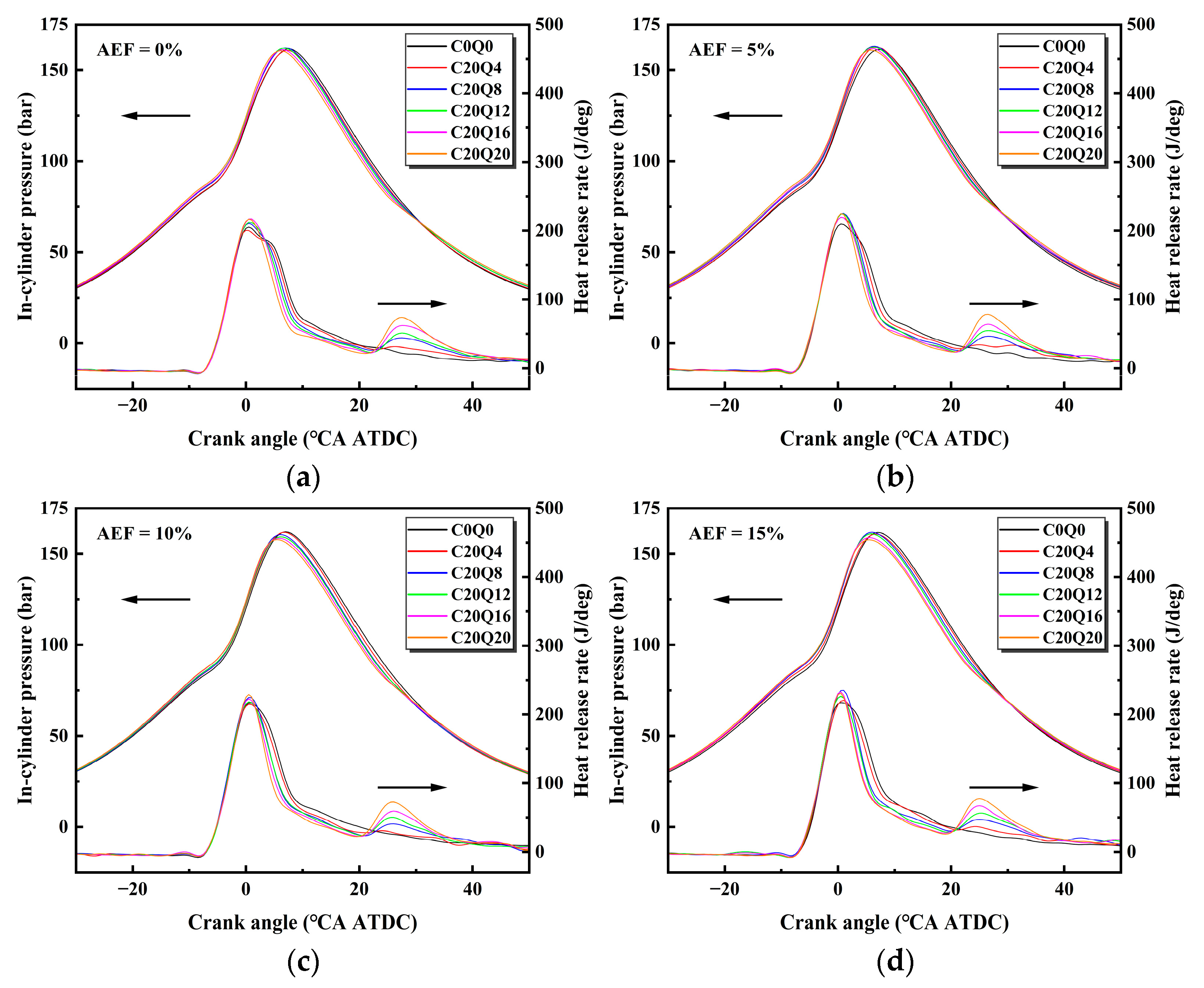
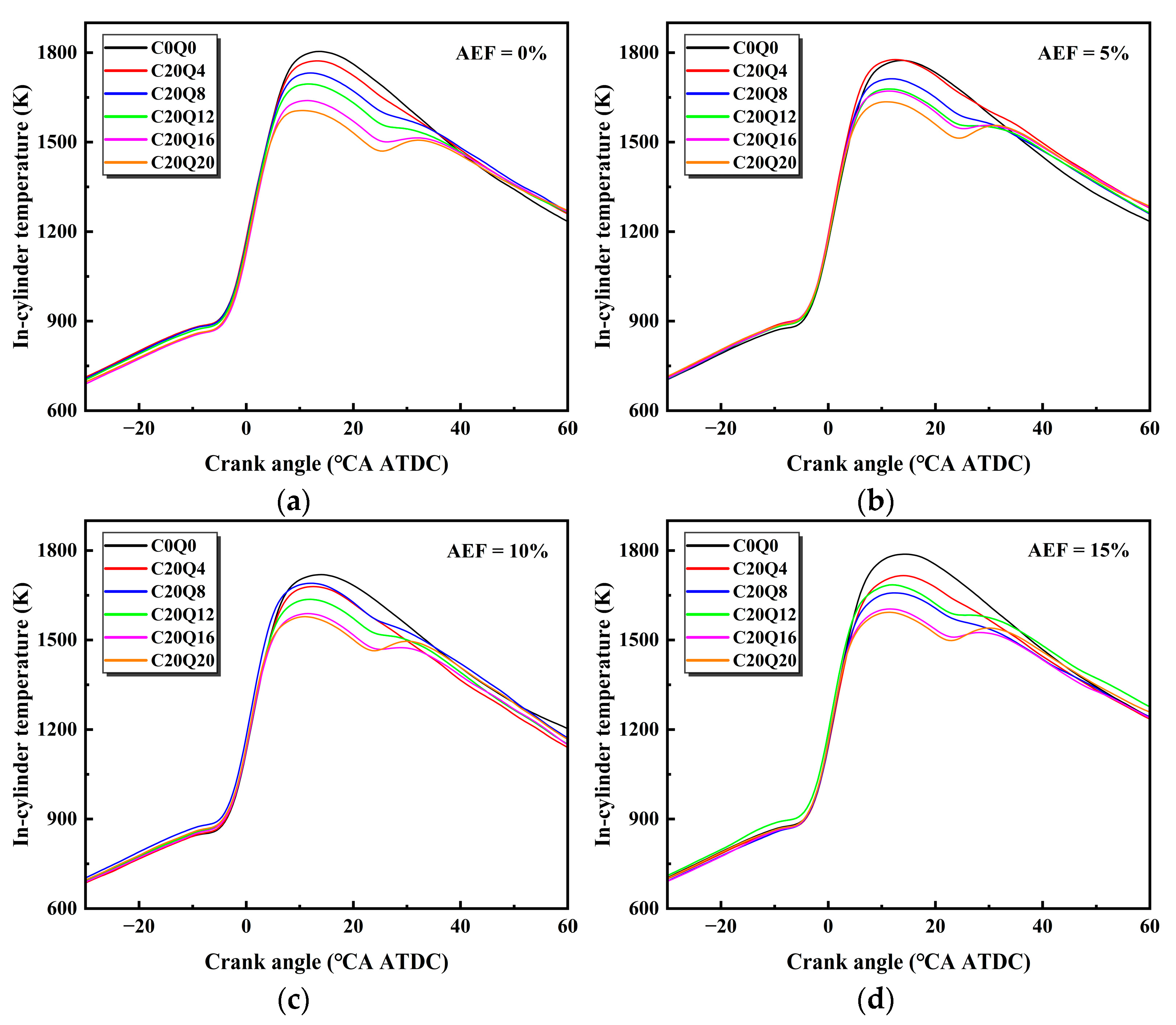
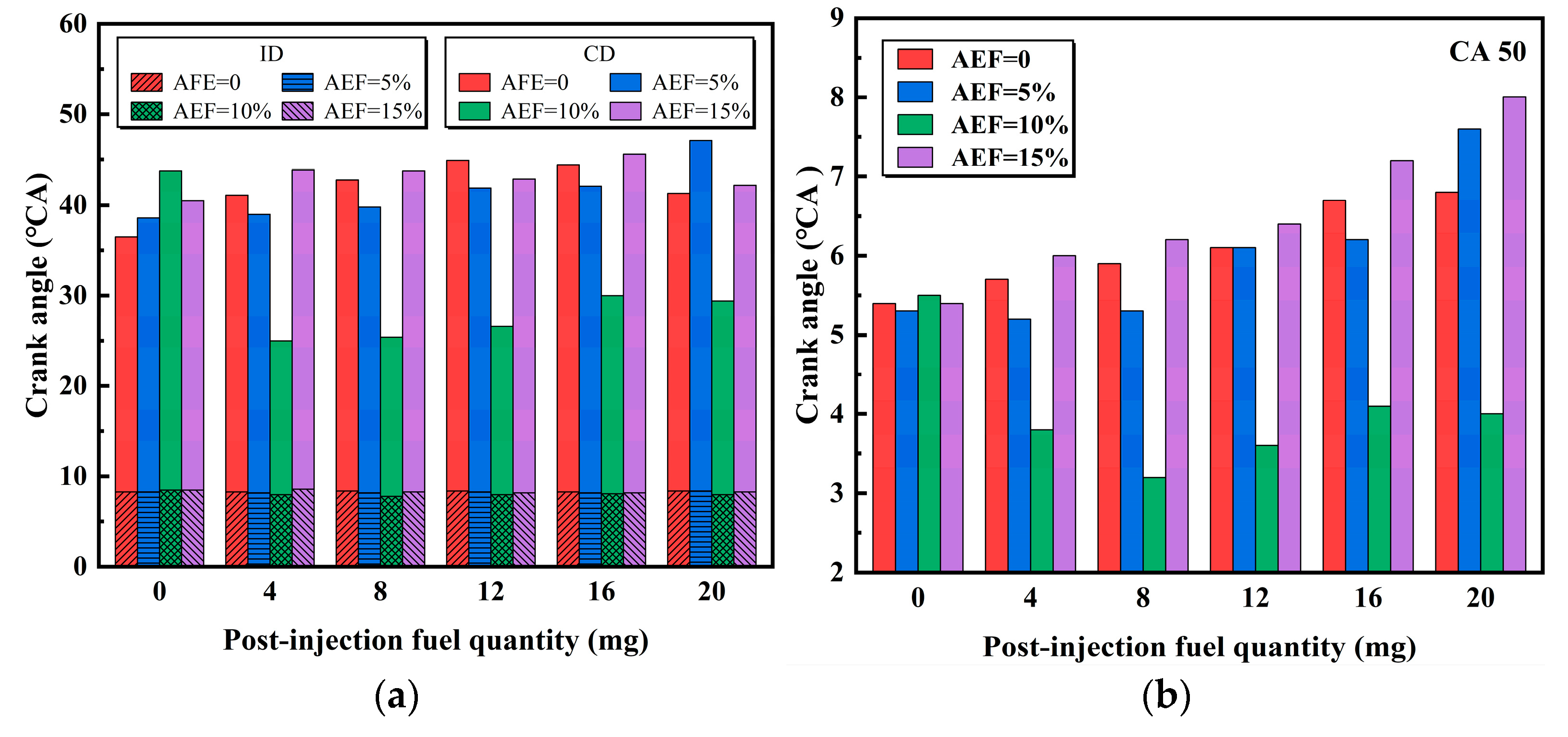
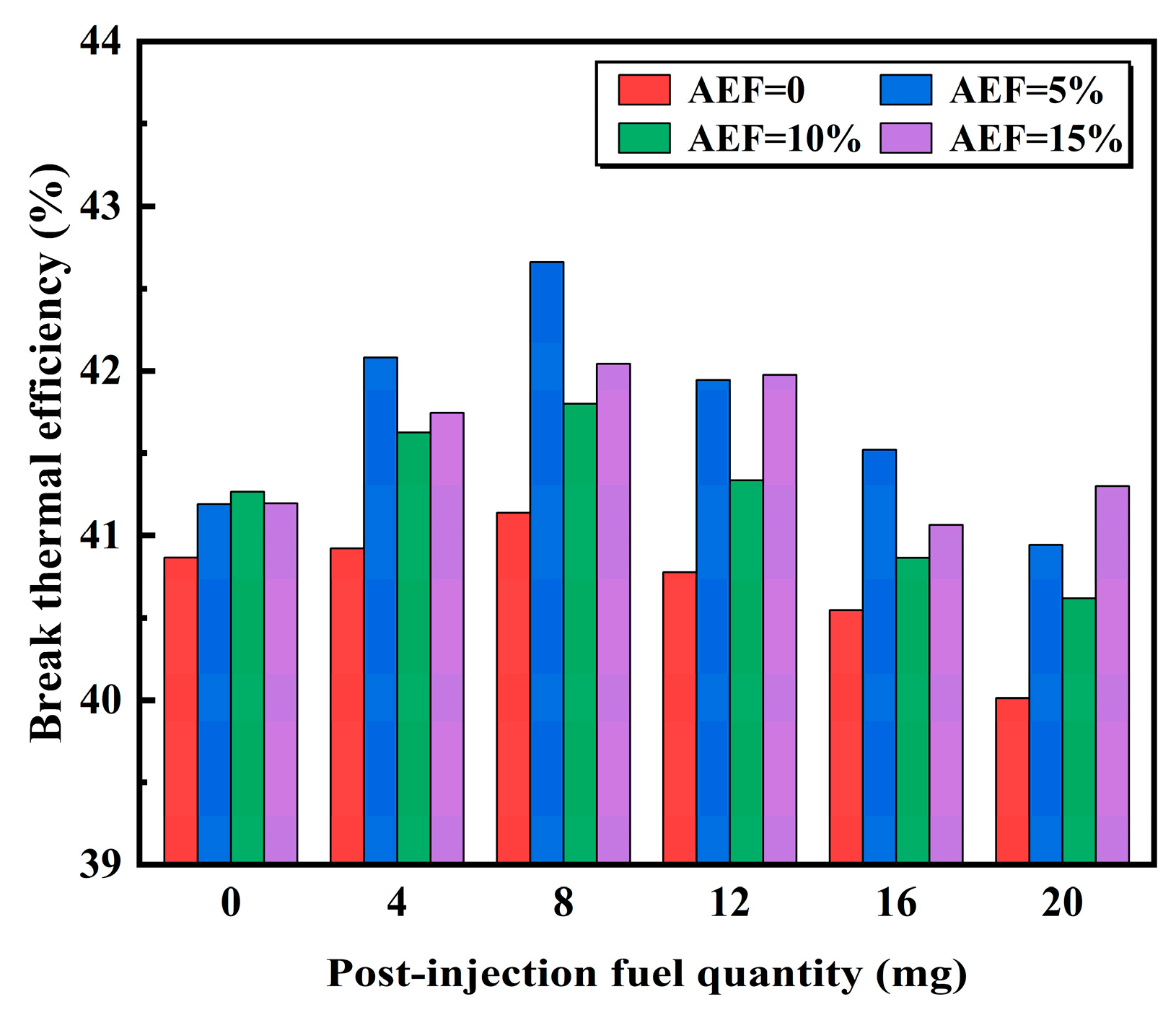
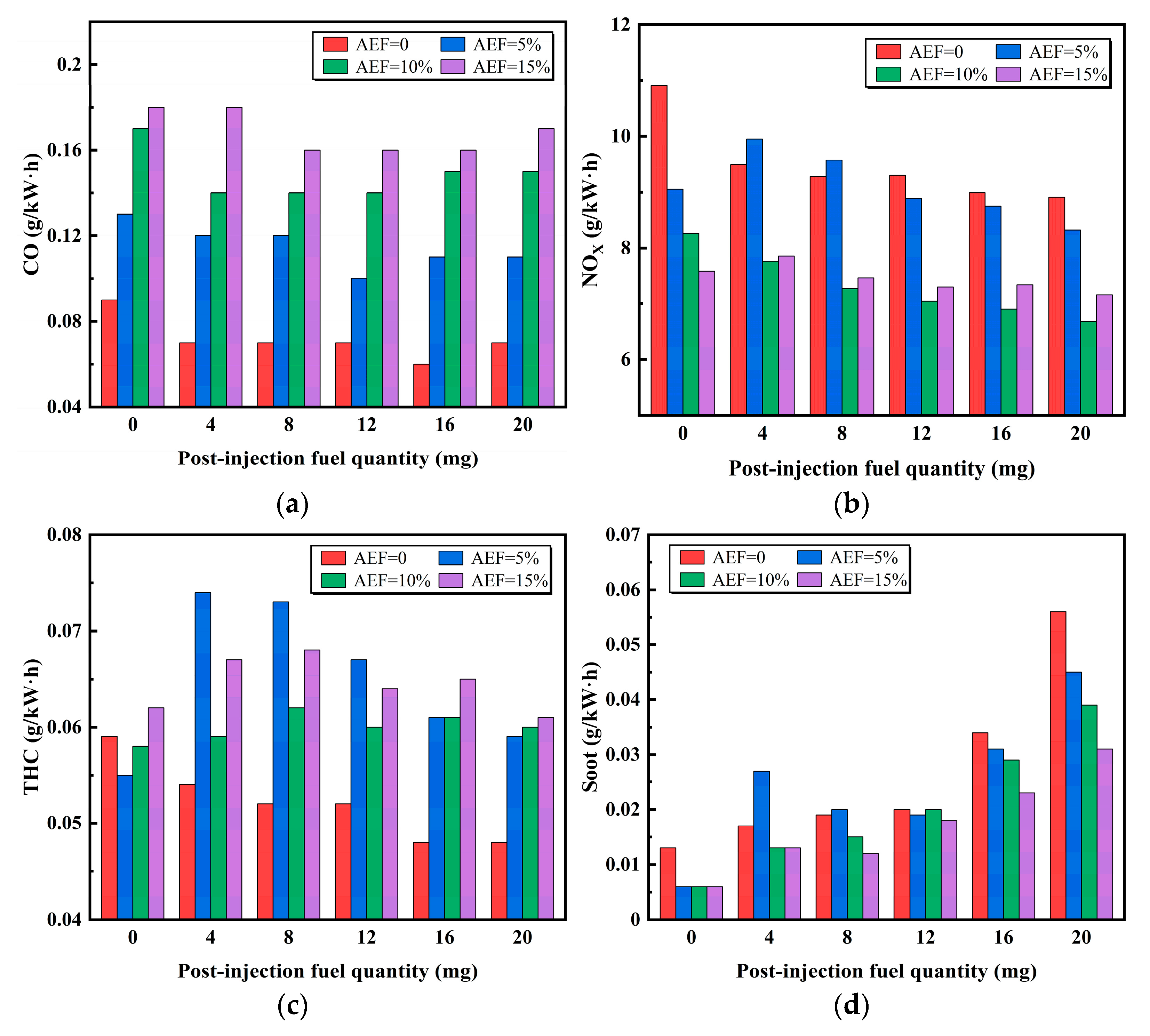
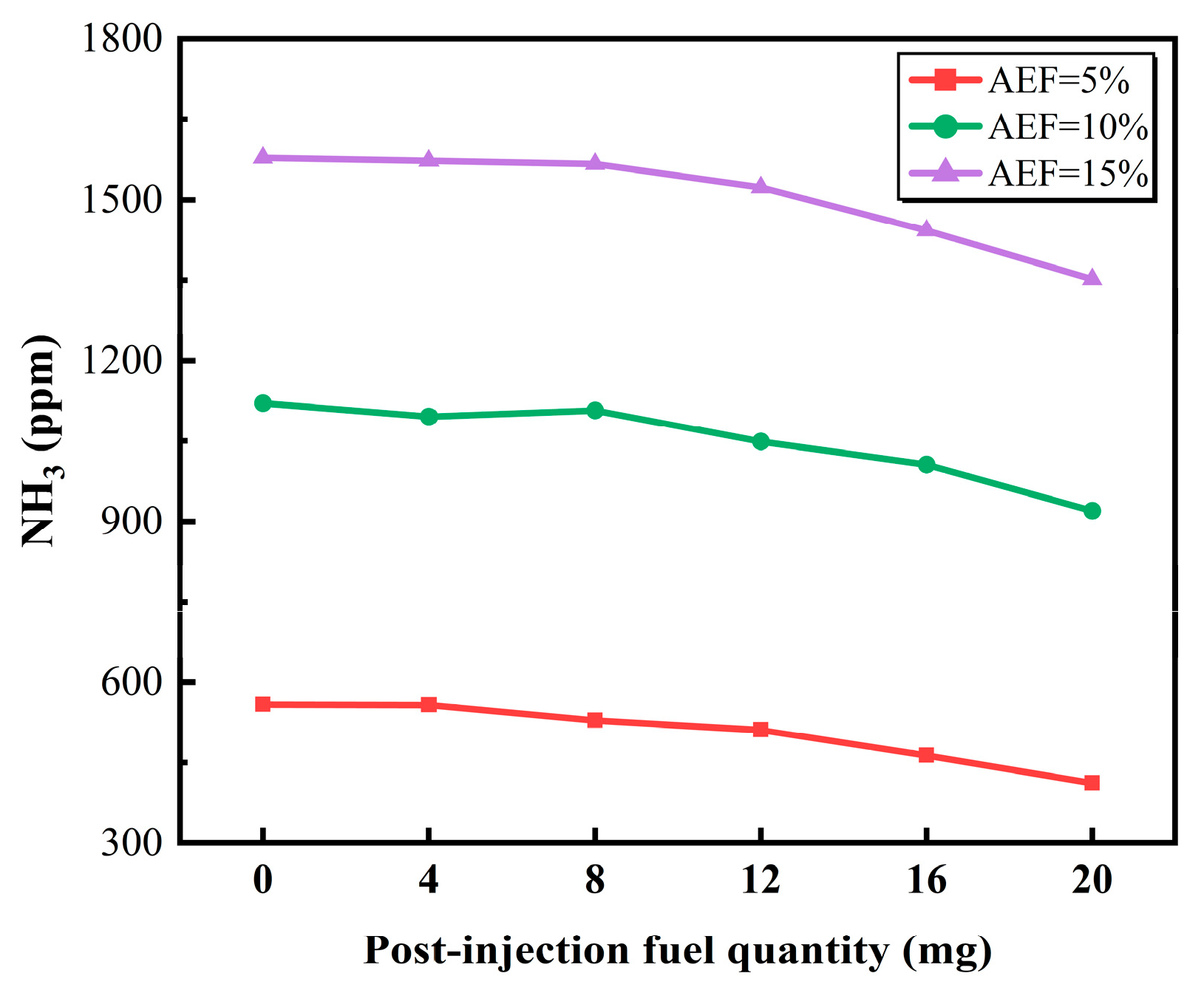
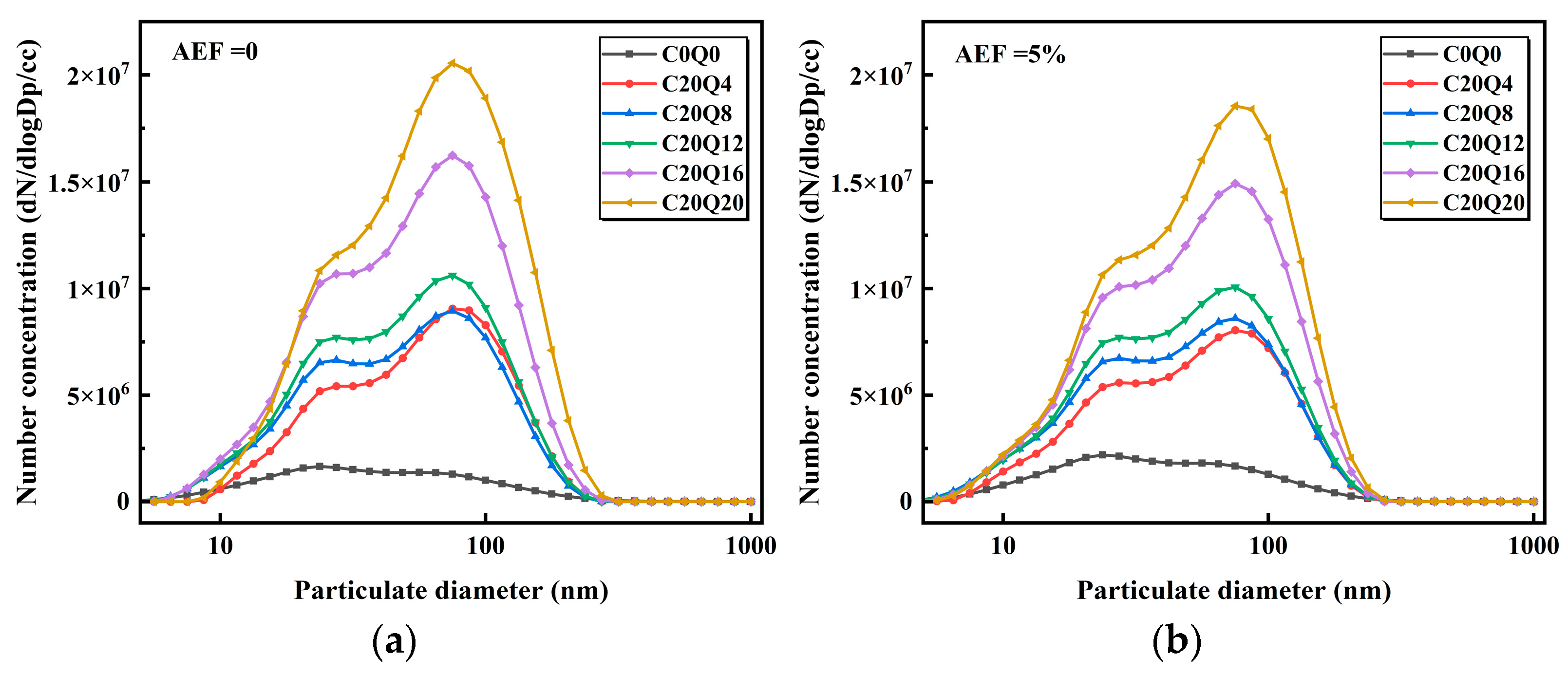
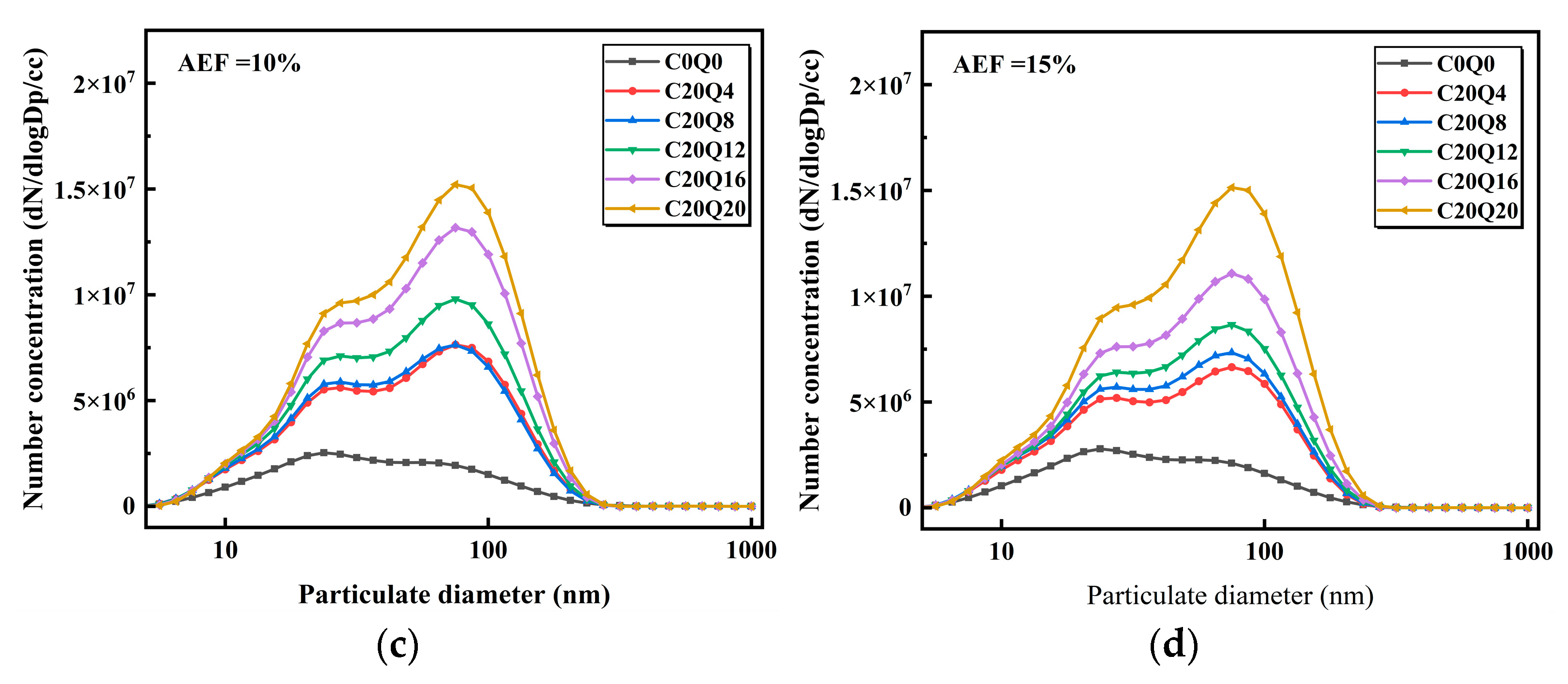

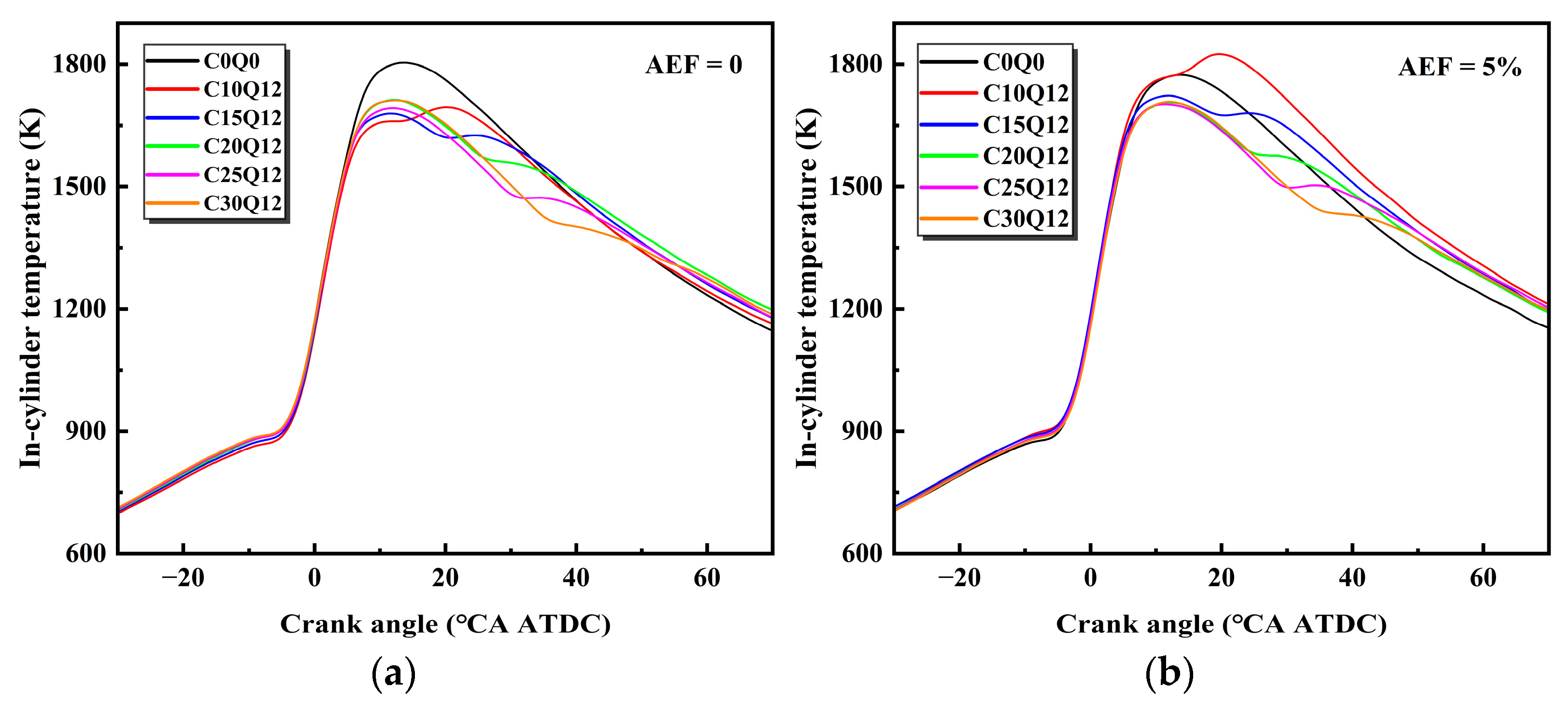
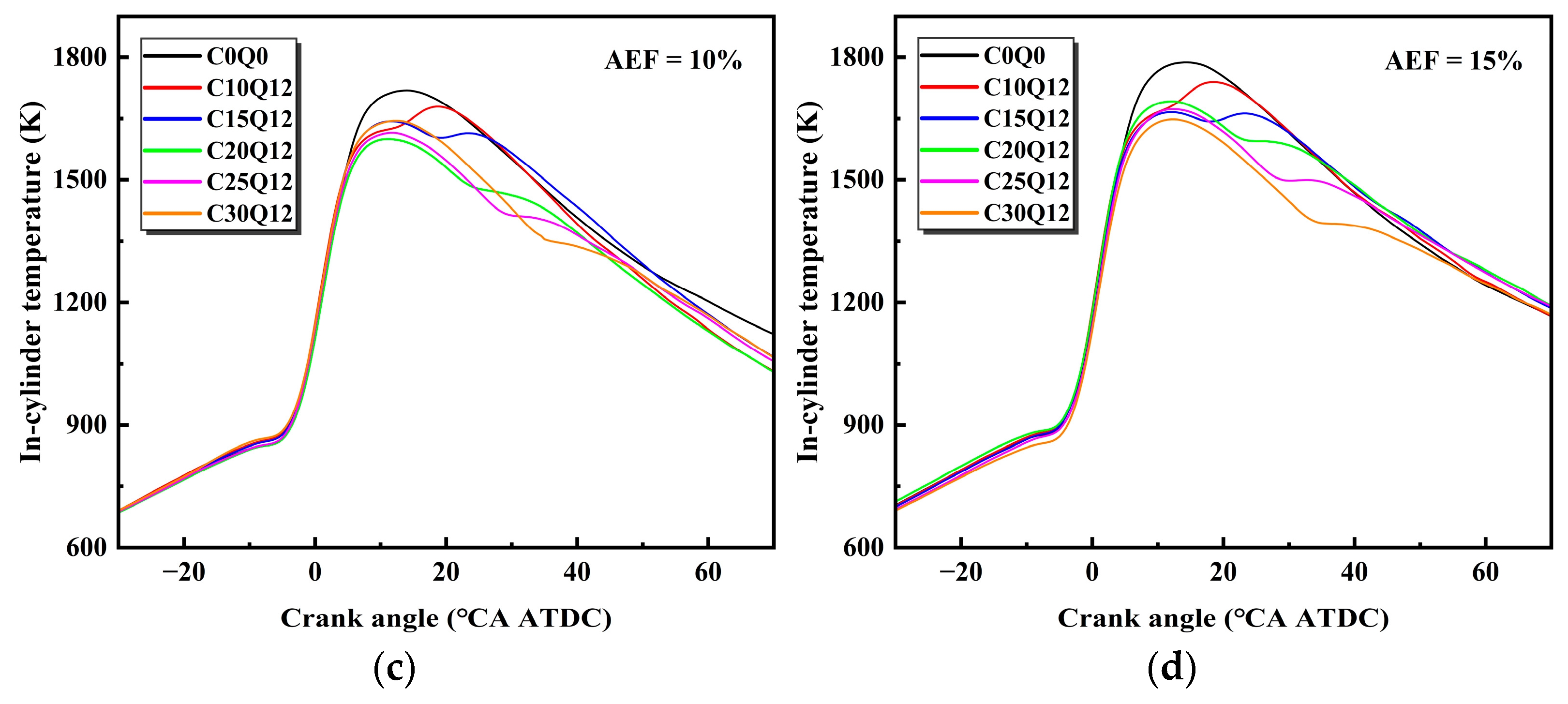
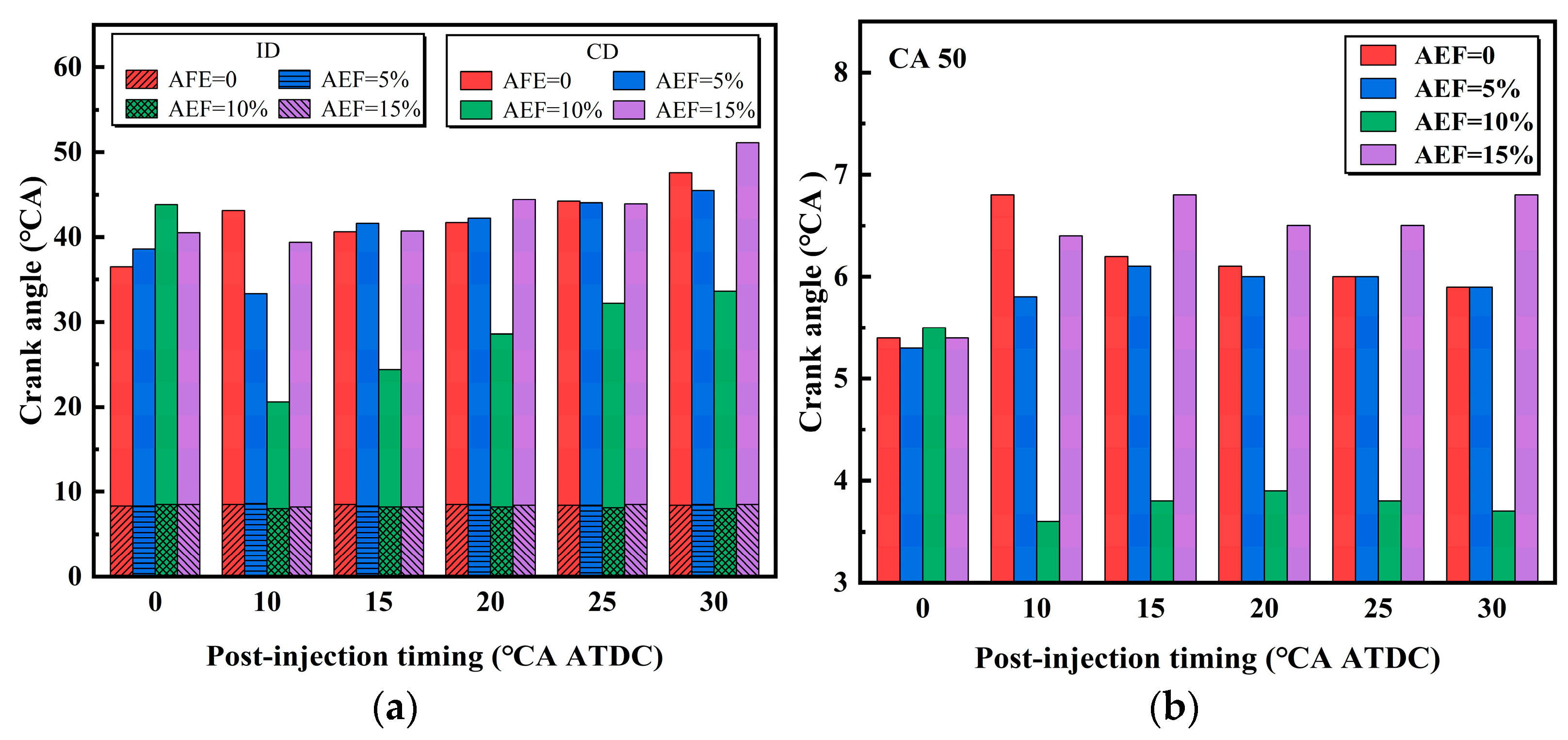
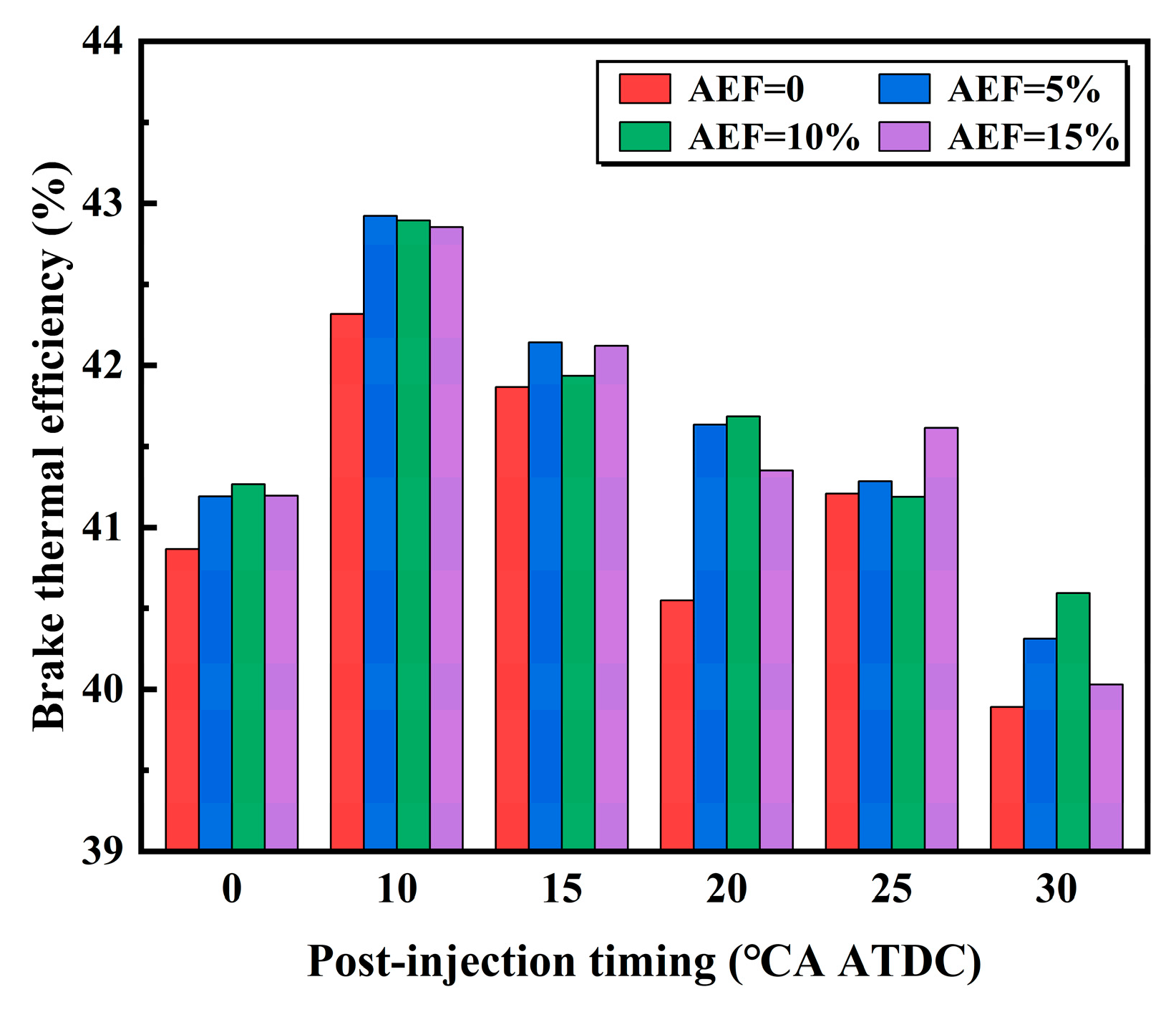
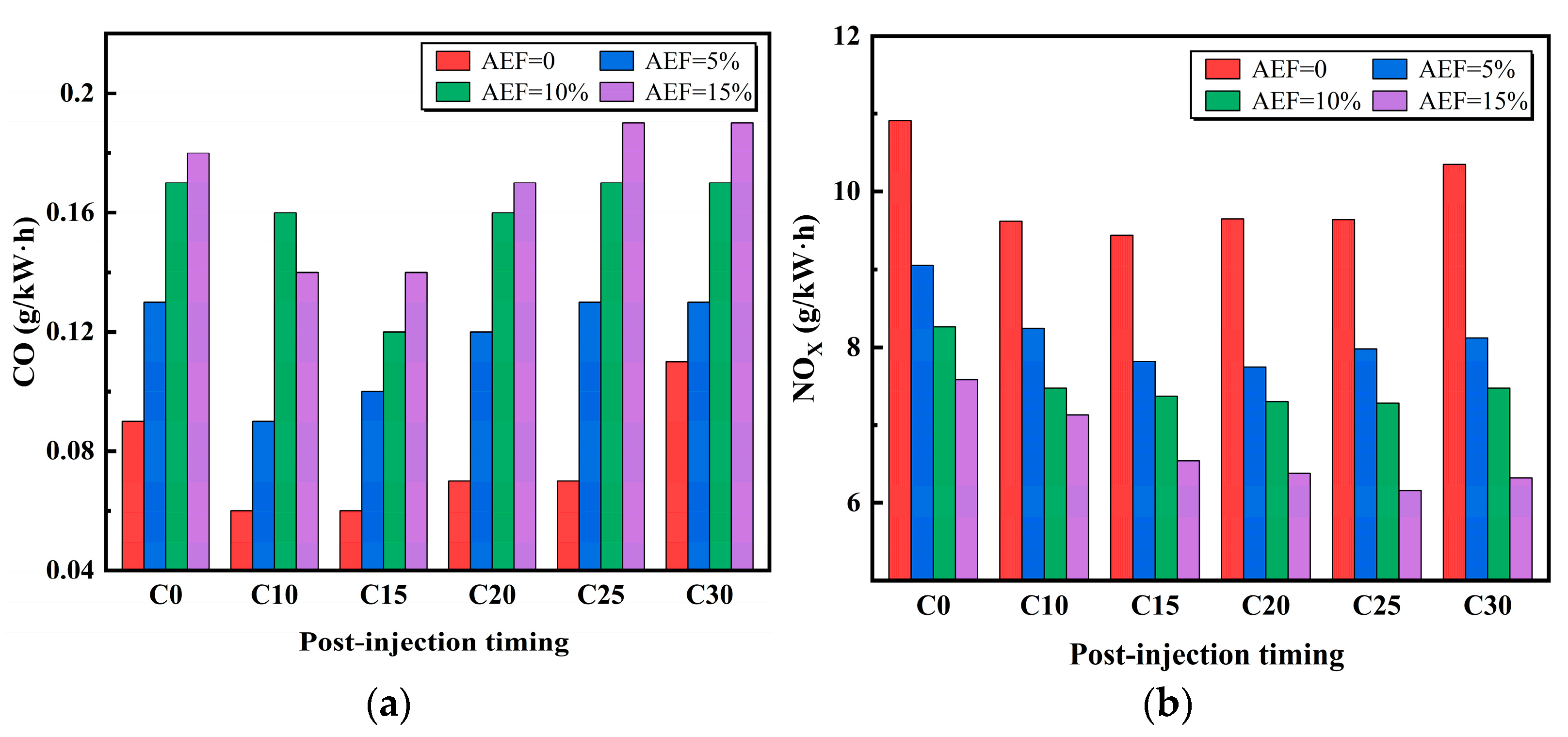
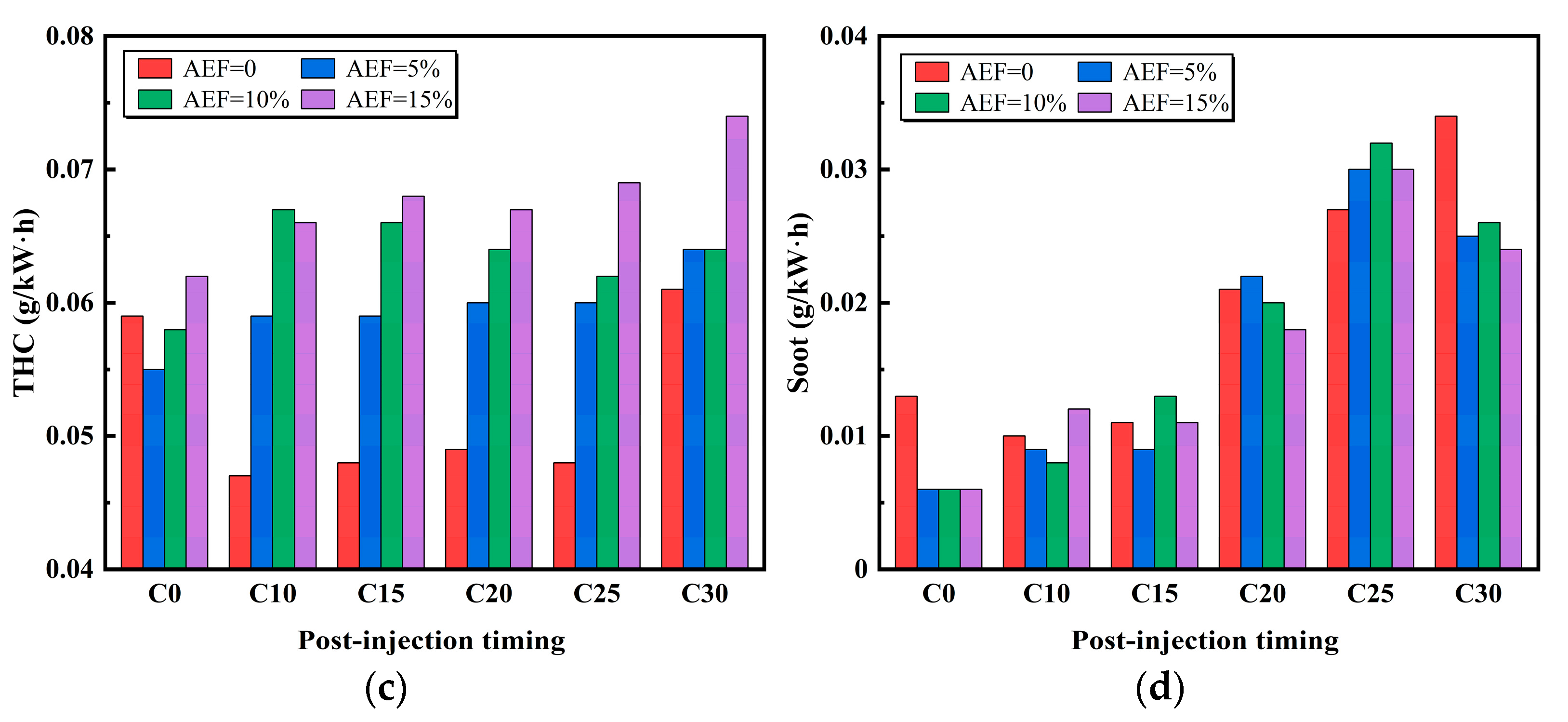

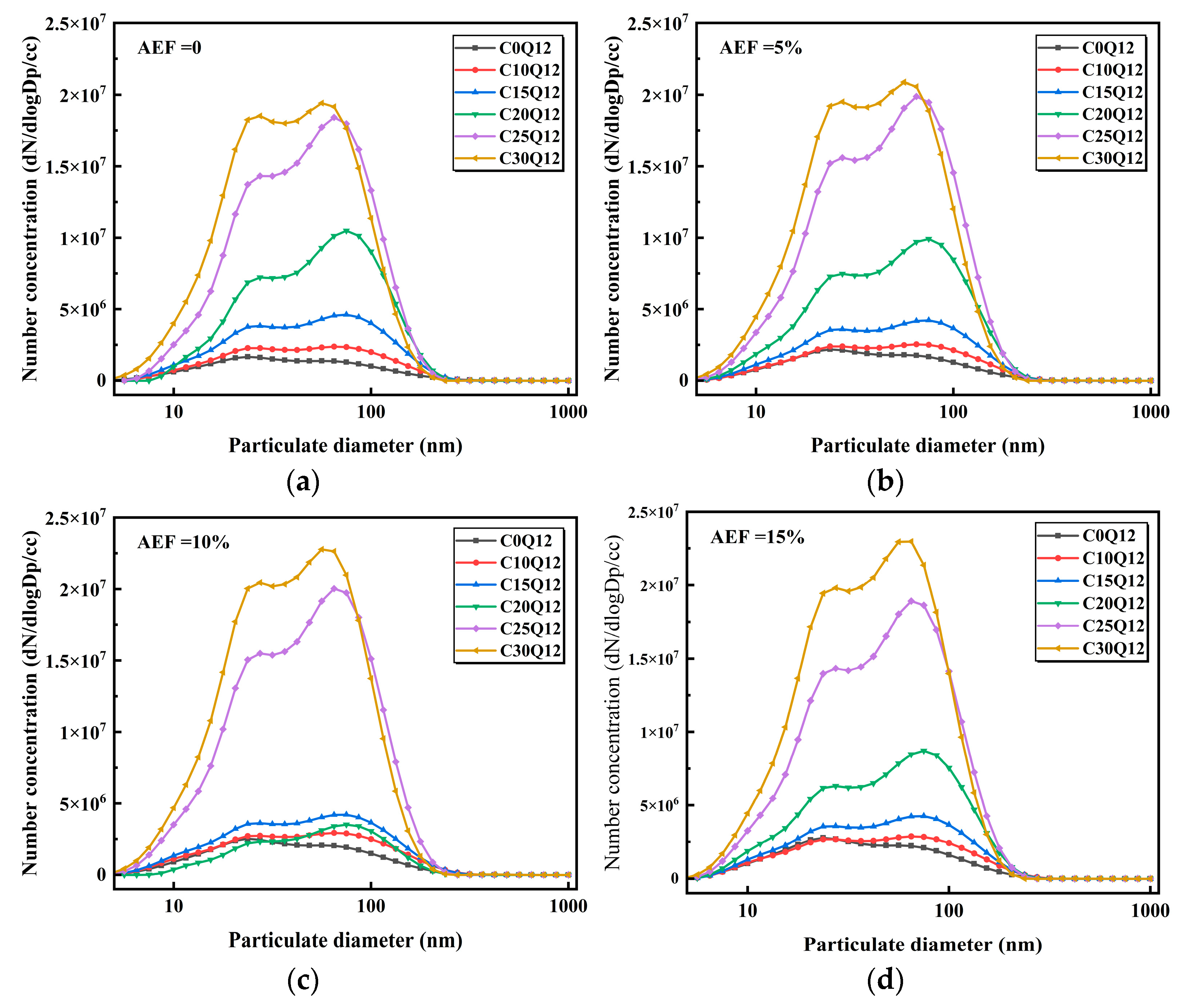
| Items | Parameters |
|---|---|
| Number of cylinders | 4 |
| Bore × stroke (mm) | 110 × 135 |
| Number of valves | 4 |
| Compression ratio | 17 |
| Maximum torque (N·m) | 900 |
| Rated speed (rpm) | 2200 |
| Rated power (kW) | 176 |
| Engine displacement (L) | 5.13 |
| Instruments | Range | Uncertainties |
|---|---|---|
| CO | 0–5000 ppm | ±0.5% |
| NOX | 0–5000 ppm | ±0.5% |
| THC | 0–10,000 ppm | ±0.5% |
| AVL 415SE | 0–10 FSN | ±0.1% |
| Kistler 6052C | 0–25 MPa | ±0.1% |
| Property | CTL | Ammonia |
|---|---|---|
| Cetane number | 75.4 | - |
| Lower heating value (MJ/kg) | 43.07 | 18.5 |
| Density (kg/m3, 20 °C) | 764 | 0.77 (liquid) |
| Viscosity (mm2/s, 20 °C) | 2.14 | - |
| Boiling point (°C) | 257.8 | −33.34 |
| Latent heat of vaporization (MJ/kg) | - | 1370 |
| Stoichiometric air-fuel ratio | 14.96 | 6.1 |
| Initial boiling point (°C) | 176.5 | - |
| Final boiling point (°C) | 313.5 | - |
| Item | Value |
|---|---|
| Engine speed (rpm) | 1200 |
| Torque (N·m) | 540 |
| IMEP (MPa) | 1.4 |
| Injection pressure (MPa) | 140 |
| Ammonia energy fraction (%) | 0, 5, 10, 15 |
| Main injection timing (°CA BTDC) | 10 |
| Post-injection quantity (mg) | 4, 8, 12, 16, 20 |
| Post-injection timing (°CA ATDC) | 10, 15, 20, 25, 30 |
| EGR rate (%) | 0 |
Disclaimer/Publisher’s Note: The statements, opinions and data contained in all publications are solely those of the individual author(s) and contributor(s) and not of MDPI and/or the editor(s). MDPI and/or the editor(s) disclaim responsibility for any injury to people or property resulting from any ideas, methods, instructions or products referred to in the content. |
© 2025 by the authors. Licensee MDPI, Basel, Switzerland. This article is an open access article distributed under the terms and conditions of the Creative Commons Attribution (CC BY) license (https://creativecommons.org/licenses/by/4.0/).
Share and Cite
Tian, S.; Zhang, L.; Wang, Y.; Huang, H. Impact of Post-Injection Strategies on Combustion and Emissions in a CTL–Ammonia Dual-Fuel Engine. Energies 2025, 18, 3077. https://doi.org/10.3390/en18123077
Tian S, Zhang L, Wang Y, Huang H. Impact of Post-Injection Strategies on Combustion and Emissions in a CTL–Ammonia Dual-Fuel Engine. Energies. 2025; 18(12):3077. https://doi.org/10.3390/en18123077
Chicago/Turabian StyleTian, Siran, Lina Zhang, Yi Wang, and Haozhong Huang. 2025. "Impact of Post-Injection Strategies on Combustion and Emissions in a CTL–Ammonia Dual-Fuel Engine" Energies 18, no. 12: 3077. https://doi.org/10.3390/en18123077
APA StyleTian, S., Zhang, L., Wang, Y., & Huang, H. (2025). Impact of Post-Injection Strategies on Combustion and Emissions in a CTL–Ammonia Dual-Fuel Engine. Energies, 18(12), 3077. https://doi.org/10.3390/en18123077






